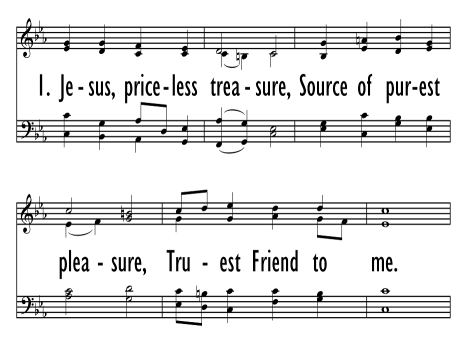Scripture References:
st. 1 = Matt. 13:44-46, John 15:1-4
st. 3 = Ps. 73:25, Phil. 3:8
The original German text “Jesu, meine Freude” by Johann Franck (PHH 305) first appeared in Johann Crüger's Praxis Pietatis Melica (1653) in six long stanzas. The text was modeled in part after a love song found in Heinrich Albert's Arein (1641), "Flora, meine Freude, meiner Seele Weide."
Catherine Winkworth (PHH 194) translated the text into English and published it in her Chorale Book for England (1863). Our version includes the original stanzas 1, 2, 4, and 6. Much loved by Christians from various traditions, “Jesus, Priceless Treasure” is one of the finest examples of German piety in a devotional hymn. The intensity of emotional expression found here provides a suitable counter¬ balance to the cerebral character of much Reformed worship.
Inspired by Jesus' parables of the great treasure and fine pearl (Matt. 13:44-46) and other New Testament references to the metaphor "treasure," this text is strongly Christocentric. Stanza 1 confesses with mystical ecstasy that Christ is the source of purest pleasure (a bold affirmation that counters the hedonism of this world). Stanza 2 expands the metaphor: Christ our treasure is also our fortress, our defense and protector from the "sin and hell" that would "assail" us. Stanza 3 contrasts the eternal pleasures of knowing Jesus with the "empty" delights of this world. And stanza 4 affirms that, despite the fears and sorrow we must bear, Jesus remains our greatest treasure and source of profound joy.
Liturgical Use
As a hymn of devotion and trust and a testimony of our joyous commitment to Christ amid the temptations of contemporary life; after Lord's Supper; profession of faith.
--Psalter Hymnal Handbook


 My Starred Hymns
My Starred Hymns








